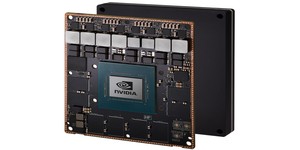Nvidia has officially announce its first Kepler-based Tegra process, the Tegra K1, which boasts 192 graphics processing cores and a choice of four 32-bit ARM Cortex-A15 cores or a pair of Nvidia-customised 64-bit versions.
Part of Nvidia's push to offer the highest-performance parts for mobile gaming devices, the new Tegra K1 processor features 192 graphics processing cores with full support for the CUDA GPGPU offload language, DirectX 11 and OpenGL 4.4 - not just the mobile-centric OpenGL ES favoured by many of its competitors - alongside the primary ARM-based central processing cores. Based on the same Kepler architecture as its latest desktop GPUs - although not the unified shader approach favoured by the desktop team - the latest chips promise considerable power at a low energy usage.
At the announcement last night, Nvidia promised two primary versions of the Tegra K1: a quad-core Cortex-A15 part, with the usual low-power 'companion core,' offering four 32-bit ARM cores running at up to 2.3GHz; or the first device in the company's Project Denver line-up, dropping to two cores but offering full 64-bit support and peak clock speeds of 2.5GHz.
Nvidia claims that the new processor brings desktop-like performance to the mobile market for the first time, and to prove that offered a demonstration of Unreal Engine 4 running directly on a Tegra K1 reference design system. Unreal's Tim Sweeney was at the unveiling, which took place on the first day of the Consumer Electronics Show in Las Vegas, to provide a handy sound-bite: 'We can take absolutely anything that runs on PC or on a console and run it on Tegra [K1],' Sweeney claimed. '[i]The differences between the platforms is really blurred.'
Sadly, Nvidia has been cagey on pricing for the parts and on how many original equipment manufacturers (OEMs) have signed up to produce Tegra K1 devices. It did, however, reveal a target market that should come as no surprise: the automotive industry, where Nvidia sees the chip powering both next-generation infotainment systems as well as controlling vehicle sub-systems directly. These applications will be developed, in part at least, at the company's automotive technology centre opened late last year in Michigan.
No release date for the first Tegra K1-based retail products was provided. To whet your appetite in the meantime, enjoy a copy of Nvidia's Tegra K1 Unreal Engine 4 demonstration.
Part of Nvidia's push to offer the highest-performance parts for mobile gaming devices, the new Tegra K1 processor features 192 graphics processing cores with full support for the CUDA GPGPU offload language, DirectX 11 and OpenGL 4.4 - not just the mobile-centric OpenGL ES favoured by many of its competitors - alongside the primary ARM-based central processing cores. Based on the same Kepler architecture as its latest desktop GPUs - although not the unified shader approach favoured by the desktop team - the latest chips promise considerable power at a low energy usage.
At the announcement last night, Nvidia promised two primary versions of the Tegra K1: a quad-core Cortex-A15 part, with the usual low-power 'companion core,' offering four 32-bit ARM cores running at up to 2.3GHz; or the first device in the company's Project Denver line-up, dropping to two cores but offering full 64-bit support and peak clock speeds of 2.5GHz.
Nvidia claims that the new processor brings desktop-like performance to the mobile market for the first time, and to prove that offered a demonstration of Unreal Engine 4 running directly on a Tegra K1 reference design system. Unreal's Tim Sweeney was at the unveiling, which took place on the first day of the Consumer Electronics Show in Las Vegas, to provide a handy sound-bite: 'We can take absolutely anything that runs on PC or on a console and run it on Tegra [K1],' Sweeney claimed. '[i]The differences between the platforms is really blurred.'
Sadly, Nvidia has been cagey on pricing for the parts and on how many original equipment manufacturers (OEMs) have signed up to produce Tegra K1 devices. It did, however, reveal a target market that should come as no surprise: the automotive industry, where Nvidia sees the chip powering both next-generation infotainment systems as well as controlling vehicle sub-systems directly. These applications will be developed, in part at least, at the company's automotive technology centre opened late last year in Michigan.
No release date for the first Tegra K1-based retail products was provided. To whet your appetite in the meantime, enjoy a copy of Nvidia's Tegra K1 Unreal Engine 4 demonstration.

MSI MPG Velox 100R Chassis Review
October 14 2021 | 15:04









Want to comment? Please log in.